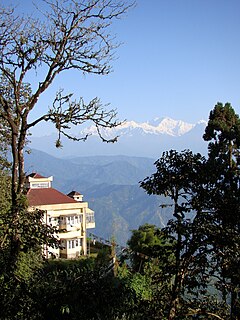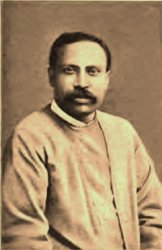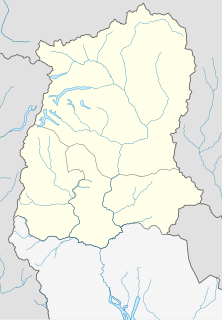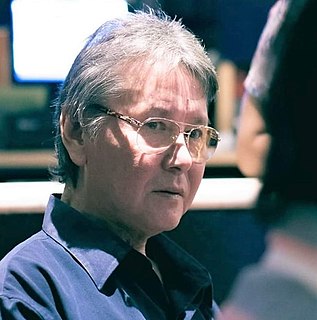
Darjeeling is a city and a municipality in the Indian state of West Bengal. It is located in the Lesser Himalayas at an elevation of 6,700 ft (2,042.2 m). It is noted for its tea industry, its views of Kangchenjunga, the world's third-highest mountain, and the Darjeeling Himalayan Railway, a UNESCO World Heritage Site. Darjeeling is the headquarters of the Darjeeling district which has a partially autonomous status within the state of West Bengal. It is also a popular tourist destination in India.

The Bhutia are a community of people of Tibetan ancestry, who speak Lhopo or Sikkimese, a Tibetan dialect fairly mutually intelligible with standard Tibetan. In 2001, the Bhutia numbered around 70,300. Bhutia here refers to Sikkimese of Tibetan ancestry; in contrast, the Bhotiya are a larger family of related Tibetan peoples in northeastern Nepal of which the Bhutia are one member group.

The history of Sikkim, an area in present-day North-East India, began in 1642 as a kingdom established when India and Nepal were still many princely states with many rulers at that time and had not unified to the present Union of India and present country of Nepal. At that time Sikkim had already solidified into country then with a king known as a Chogyal or dharma king, and till 16 May 1975 was an independent country ruled by the monarchs. Sikkim had twelve kings; Palden Thondup Namgyal was the last king of Independent Sikkim. There was contacts between ancient Hindus and Tibetans, followed by the establishment of a Buddhist kingdom or Chogyal in the 17th century. Sikkim emerged as a polity in its own right against a backdrop of incursions from Tibet and Bhutan, during which the kingdom enjoyed varying degrees of independence. In the early 18th century, the British Empire sought to establish trade routes with Tibet, leading Sikkim to fall under British suzerainty until independence in 1947. Initially, Sikkim remained an independent country, until it merged with India in 1975 after a decisive referendum. Many provisions of the Indian constitution had to be altered to accommodate the international treaties between Sikkim and India.

Kurseong is a city and a municipality in Darjeeling district in the Indian state of West Bengal. It is the headquarters of the Kurseong subdivision.

Mirik is a small town and a municipality of Darjeeling district in the state of West Bengal, India. It is the headquarters of the Mirik subdivision. The name Mirik comes from the Lepcha words Mir-Yok meaning "place burnt by fire".

Pedong is a town in Kalimpong district in the Indian state of West Bengal, located at 27.15°N 88.6167°E.

Ghum is a small hilly locality in the Darjeeling Himalayan hill region of West Bengal, India. It comes under ward number one of the Darjeeling Municipality. Ghum railway station of the Darjeeling Himalayan Railway is the highest railway station in India. It is situated at an altitude of 2,258 metres (7,407 ft). The place is the home of the Ghum Monastery and the Batasia Loop, a bend of the Darjeeling Himalayan Railway.

Bhutia Busty monastery or Karma Dorjee Chyoling monastery is a Buddhist monastery located in Bhutia Busty, Darjeeling district, India. It belongs to the Red Sect of Buddhist Lamas.

Mag-Dhog Yolmowa Monastery is a gompa in the town of Darjeeling in the Indian state of West Bengal. The monastery is also known as "Aloobari" monastery after the locality it is located in. The monastery was built under the supervision of Sri Sangay Lama, a highly revered religious head of the Yolmo people - a small ethnic group hailing from north-east of Nepal and who later settled in Darjeeling. The construction of the monastery started in 1914, the year World War I started. The name Mag-Dhog means warding off the war and the monastery was dedicated for world peace.

Observatory Hill is a hill near Chowrasta square, or The Mall as it is popularly known, in Darjeeling, West Bengal, India. Views of snow-clad peaks, including Mount Kanchenjunga, are visible from the Observatory Hill. The Bhutia Busty monastery was originally located here. Now the hill has the temple of Mahakal. Two important arteries of the town, Nehru Road and Bhanubhakta Sarani, meet at Chowrasta. Another school of thought suggests that the presence of the megalithic core to have been a place of worship of the Rongs, representing a sacred location of the classic Long Chok type. The term 'Dotsug' was thus a literal translation of 'Long Chok'

Sarat Chandra Das (1849–1917) was an Indian scholar of Tibetan language and culture most noted for his two journeys to Tibet in 1879 and in 1881–1882.

The culture of Darjeeling, India, is quite diverse and unique. The two predominant religions are Hinduism and Vajrayana Buddhism. Dashain, Tihar, Buddha Jayanti, Christmas, Holi, Ram Navami, etc. are the main festivals. Besides, the diverse ethnic populace of the town also celebrates several local festivals. Buddhist ethnic groups such as the Lepchas, Bhutias, Sherpas, Yolmos, Gurungs, and Tamangs celebrate new year called Losar in January/February, Maghe Sankranti, Chotrul Duchen, and Tendong Lho Rumfaat. The Kiranti Rai people (Khambus) celebrate their annual Sakela festivals of Ubhauli and Udhauli. Deusi and Bhaileni are songs performed by men and women, respectively, during the festival of Tihar. All these provide a "regional distinctness" of Darjeeling's local culture from the rest of India. Darjeeling Carnival, initiated by a civil society movement known as The Darjeeling Initiative, was a ten-day carnival held yearly during winter that portrayed the rich musical and cultural heritage of Darjeeling Hills as its central theme. Every year, cultural festivals are held in the town of Darjeeling and its surrounding areas.

Pakim is a town in the East Sikkim district of the Indian state of Sikkim, located in the foothills of the Himalayas. It is the headquarters of the Pakyong Administrative division and hosts many government offices. Pakyong was a small settlement until the central government approved a new greenfield airport, to be constructed by Punj Lloyd.

Kabi Lungchok is a historic site of significance, which is located 17 kilometres (11 mi) north of Gangtok on the Northern Highway in northeastern Indian state of Sikkim. The historicity of the site is attributed to the fact that the Lepchas, the ethnic tribals of Sikkim and Bhutias, the immigrants from southern Bhot who settled down in Sikkim from the 14th century onwards, ceremonially signed a "Treaty of Blood Brotherhood" with religious fervour. Stone pillars mark the location where the treaty was signed. The Treaty was signed at Kabi Lungchok by the Bhot King, Khye Bumsa representing the Bhutias and the Lepcha Chief Thekong Tek. The literal meaning of 'Kabi Lungchok', pronounced ‘Kayu sha bhi Lungchok’, is "stone erected by our blood." Life-size statues of the Lepcha and Bhutia 'blood-brothers' who signed the treaty has been erected here.
Tourist attractions in West Bengal refers to the tourist attractions in the Indian state of West Bengal. West Bengal is a state in the eastern region of India and is the nation's fourth-most populous. It is also the seventh-most populous sub-national entity in the world, with over 91 million inhabitants. It is bordered by the countries of Nepal, Bhutan, and Bangladesh, and the Indian states of Orissa, Jharkhand, Bihar, Sikkim, and Assam. The state capital is Kolkata. West Bengal encompasses two broad natural regions: the Gangetic Plain in the south and the sub-Himalayan and Himalayan area in the north. With these there are two major natural regions i.e., the Western plateau and the great Sundarban delta.

Ging Gompa is a Buddhist monastery in Darjeeling, India.
Bhutia are a community of Tibetan people. Bhutia may also refer to

The Mahakal Temple or Mahakal Mandir is a sacred Hindu temple located in Darjeeling in the state of West Bengal, India dedicated to the Hindu god Lord Shiva, the third god in the Hindu triumvirate. The Temple was built in 1782 by Lama Dorjey Rinzing and is perched atop the Observatory Hill in Darjeeling and is an amalgamation of Hindu and Buddhist religions. It is a unique religious site where both religions coexist harmoniously.

Norden Tenzing Bhutia was a musician, composer and singer of classic Nepali language songs like 'Musu Musu Hasi Deu', 'Gajalu le Aakhai Chopne', 'Kaha Timro Mayalu Lai'. In the 70's Bhutia was the vocalist and guitarist of the very popular Nepali ensemble, ‘The Himalayan Band’. Bhutia is credited with transforming Nepali music and heralding a change in musical taste and content. Bhutia was one of the pioneers to introduce rock, pop and blues to Nepali mainstream music.















